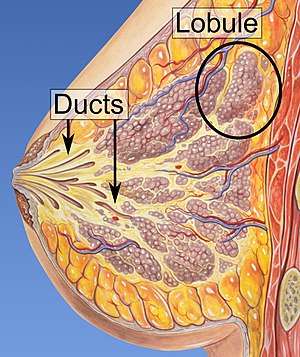Lobe (anatomy)
In anatomy, a lobe is a clear anatomical division or extension[1] of an organ (as seen for example in the brain, lung, liver, or kidney) that can be determined without the use of a microscope at the gross anatomy level. This is in contrast to the much smaller lobule, which is a clear division only visible under the microscope.[2]
| Lobes | |
|---|---|
 Visceral surface of the liver showing the four lobes | |
| Identifiers | |
| TA | A13.1.02.002 |
| FMA | 45728 |
| Anatomical terminology | |
Interlobar ducts connect lobes and interlobular ducts connect lobules.
Examples of lobes
- The four main lobes of the brain
- the frontal lobe
- the parietal lobe
- the occipital lobe
- the temporal lobe
- The three lobes of the human cerebellum
- the flocculonodular lobe
- the anterior lobe
- the posterior lobe
- The two lobes of the thymus
- The two and three lobes of the lungs
- Left lung: superior and inferior
- Right lung: superior, middle, and inferior
- The four lobes of the liver
- Left lobe of liver
- Right lobe of liver
- Quadrate lobe of liver
- Caudate lobe of liver
- The renal lobes of the kidney
Examples of lobules

Lobules of the mammary glands.
- the cortical lobules of the kidney
- the testicular lobules of the testis
- the lobules of the mammary gland
- the pulmonary lobules of the lung
- the lobules of the thymus
gollark: "yes, I have my computer backed up to a bunch of amoebas in this tank here, how about you?"
gollark: Unless you want backup copies, I suppose.
gollark: It can only carry the data you originally packed it with, after all.
gollark: Having it self-replicate would be useless.
gollark: Flash memory is already ridiculously dense *and* still pretty fast with good I/O.
References
- lobe Archived 2017-09-27 at the Wayback Machine at eMedicine Dictionary
- SIU SOM Histology GI
This article is issued from Wikipedia. The text is licensed under Creative Commons - Attribution - Sharealike. Additional terms may apply for the media files.